** The Amazing Cell **
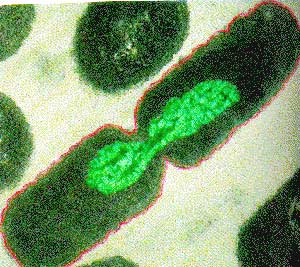 Up until the mid-20th century, the cell was initially thought to be simple. Ernst Haeckel famously stated that the cell is nothing more than an undifferentiated piece of protoplasm, meaning, in today's language, a blob of Jello. So that's how you evolved. To quote Dr. Mark Eastman, "From the goo to the zoo to you."
Up until the mid-20th century, the cell was initially thought to be simple. Ernst Haeckel famously stated that the cell is nothing more than an undifferentiated piece of protoplasm, meaning, in today's language, a blob of Jello. So that's how you evolved. To quote Dr. Mark Eastman, "From the goo to the zoo to you."As new technologies emerged, such as the electron microscope, scientists found themselves confronted not with Haeckel's homogenous blob of protoplasm, but rather, with a system of complexity far beyond anything we could have imagined.
It turns out that even the simplest known cells are a highly organized, micro-miniaturized city looking like something straight out of a science fiction film. The spectacle features automated assembly plants manufacturing hundreds of thousands of specific products, databanks employing artificial languages and decoding systems, mobile power plants generating energy, chemical stations and refineries for breaking down raw materials into their usable parts, transportation networks and channels complete with highways, traffic rules and law enforcement, border control and sensory devices regulating the arrival and departure of substances, and a host of other things we don't even begin to understand.
Am I exaggerating? Let me quote Michael Denton, a geneticist and agnostic:
To grasp the reality of life as it has been revealed by molecular biology, we must magnify a cell a thousand million times until it is twenty kilometres in diameter and resembles a giant airship large enough to cover a great city like London or New York. What we would then see would be an object of unparalleled complexity and adaptive design. On the surface of the cell we would see millions of openings, like the port holes of a vast space ship, opening and closing to allow a continual stream of materials to flow in and out. If we were to enter one of these openings we would find ourselves in a world of supreme technology and bewildering complexity. We would see endless highly organized corridors and conduits branching in every direction away from the perimeter of the cell, some leading to the central memory bank in the nucleus and others to assembly plants and processing units. The nucleus itself would be a vast spherical chamber more than a kilometre in diameter, resembling a geodesic dome inside of which we would see, all neatly stacked together in ordered arrays, the miles of coiled chains of the DNA molecules. A huge range of products and raw materials would shuttle along all the manifold conduits in a highly ordered fashion to and from all the various assembly plants in the outer regions of the cell.To add to the amazement this great, complex, and busy metropolis reproduces itself in a matter of hours!
We would wonder at the level of control implicit in the movement of so many objects down so many seemingly endless conduits, all in perfect unison. We would see all around us, in every direction we looked, all sorts of robot-like machines. We would notice that the simplest of the functional components of the cell, the protein molecules, were astonishingly, complex pieces of molecular machinery, each one consisting of about three thousand atoms arranged in highly organized 3-D spatial conformation... Yet the life of the cell depends on the integrated activities of thousands, certainly tens, and probably hundreds of thousands of different protein molecules.
We would see that nearly every feature of our own advanced machines had its analogue in the cell: artificial languages and their decoding systems, memory banks for information storage and retrieval, elegant control systems regulating the automated assembly of parts and components, error fail-safe and proof-reading devices utilized for quality control, assembly processes involving the principle of prefabrication and modular construction. In fact, so deep would be the feeling of deja-vu, so persuasive the analogy, that much of the terminology we would use to describe this fascinating molecular reality would be borrowed from the world of late twentieth-century technology.
What we would be witnessing would be an object resembling an immense automated factory, a factory larger than a city and carrying out almost as many unique functions as all the manufacturing activities of man on earth.. (Michael Denton, Evolution, a Theory in Crisis, pg.250)
Hard to imagine, isn't it? But we can actually get a glimpse into this bewildering world with David Bolinsky's short computer-generated animation commissioned by Harvard University. It took about 14 months to produce these few minutes and is still an ongoing process. Bolinksy admits "believe me we know maybe one percent of what's going on [in cells]". (Ted.com video: David Bolinsky visuallizing the wonder of a cell, at 8:38)
John Liebler, the lead animator, said: "All of those things that you see in the animation are going on in every one of your cells in your body all the time... I've been in the medical animation field for seven years now, so I'm a little jaded, but I still get surprised by things. For instance, in the animation there's a motor protein that's sort of walking along a line, carrying this round sphere of lipids. When I started working on that section I admit I was kind of surprised to see that it really does look like it's out for a stroll, like a character in a science fiction film or animation. But based on all the data, it's a completely accurate rendering."[1] (though simplified for in real life things happen in a much more crowded, much harder to view manner)
(see below for the video)
Just briefly, to get a feel for what cells need to do, let us consider the basic autonomous cell whose task is to reproduce and synthesize the parts it needs from raw materials.
1. Information System - to build something which can reproduce and synthesize its own parts from raw materials requires a coordinated series of steps. Chemicals cannot do this. On their own, they just combine chaotically or crystallize into regular patterns such as in snowflakes. Hence, there must be information (ex. RNA or the like) storing the instructions to orchestrate the assembly.
2. Energy System - information by itself is useless. To implement the instructions requires energy. A system that cannot generate or source energy just drifts chaotically or crystallizes into simple forms, forced to follow the path of least resistance. Hence, a system of producing or sourcing energy is necessary along with subsystems of distribution and management of that energy so that it goes to the proper place.
3. Copy System - in order to reproduce itself, the device must be able to implement the instructions of the information system using the energy system. This includes the ability to rebuild all critical infrastructure such as the information and energy systems and even the copy system itself.
4. Growth System - Without a growth system, the device will reduce itself every time it reproduces and vanish to zero-size after a few generations. This growth system necessitates subsystems of ingestion of materials from the outside world, processing of those materials, and assembling those materials into the necessary parts.This alone is a formidable chemical factory.
5. Transportation System - the materials must be moved to the proper places. Hence, a transportation system is needed for transporting raw materials and products from one place to another within the cell. Likewise, a system for managing the in-coming of raw materials and out-going of waste materials of all these chemical reactions.
6. Timing System - the growth system must also be coordinated with the reproduction system. Otherwise, if the reproduction occurs faster than the growth, it will reduce size faster than it grows and vanish after a few generations. Hence, a timing or feedback mechanism is needed.
7. Communication System - signalling is needed to coordinate all the tasks so that they all work together. The reproduction system won't work without coordination with the growth and power systems. Likewise, the power system by itself is useless without the growth and reproduction systems. Only when all the systems and "circuitry" are in place and the power is turned on is there hope for the various interdependent tasks to start working together. Otherwise, it is like turning on a computer which has no interconnections between the power supply, CPU, memory, hard drive, video, operating system, etc - nothing to write home about.
Hence the "simple" task of reproducing and synthesizing parts is by no means simple. A cell is a marvellous entity no less mind-boggling than a full fledged organism.
 Furthermore, all of this complexity is just for the basic cell. Consider for instance, all the processes that need to occur in the human egg cell after fertilization. It magnifies its size in only a few weeks or months thousand-folds and more. It self-organizes into some trillion specialized cells. What system known in reality is able to do so, only with mother's food and air digested and moved through the blood. Nothing like it even a tiny bit 1000 times exists anywhere ever. Such brilliant ability to magnify a structure by such an enormous factor, such sophistication and wisdom of creation - all autonomously in the womb. (based on a teaching by Rabbi Omer Furmanski).
Furthermore, all of this complexity is just for the basic cell. Consider for instance, all the processes that need to occur in the human egg cell after fertilization. It magnifies its size in only a few weeks or months thousand-folds and more. It self-organizes into some trillion specialized cells. What system known in reality is able to do so, only with mother's food and air digested and moved through the blood. Nothing like it even a tiny bit 1000 times exists anywhere ever. Such brilliant ability to magnify a structure by such an enormous factor, such sophistication and wisdom of creation - all autonomously in the womb. (based on a teaching by Rabbi Omer Furmanski).
All this makes ever more poignant the words of Rabbi Moshe Chaim Luzzato (17th century) commenting on a verse in our daily prayers.
You should know that all of G-d's works are awesome, infinitely broad and deep. This is the meaning of "how great are Your works O, G-d" (Ps. 92:6). The least of His works contains such degree of wisdom, in quantity and depth, that it is impossible for us to ever fully grasp it. This is the meaning of (the second half of the verse): "Your thoughts are exceedingly deep" (i.e. infinitely deep). We can only grasp the superficial surface of the works of G-d.. (Daas Tevunos sec.54)Indeed, the more we discover, the more we realize how much more there is to know. This wisdom, in other words, is of a different kind of wisdom than ours. It is of the infinite enclothed in the finite - precisely the concept of creation.
Some assert there are no miracles in nature. But really the miracle is right under our noses - for the bottomless divine wisdom in all living things is itself a miracle.
Furthermore, this way teaches us far more about the infinite power, wisdom and ability of the Creator than any "supernatural" miracle.
(Note that whenever one reads news stories of "artificial cells" created in the lab, he can safely assume it is something that neither grows nor reproduces, for that would require all the above complexity. Alternatively, it is just a modification of an already living organism and then hoping it will survive the change.)
The following short videos give a glimpse into the awe-inspiring world of the cell which we are only beginning to understand.
 |
Inner life of the cell Harvard University's computer generated animation giving a glimpse into the world of cells.watch | download |
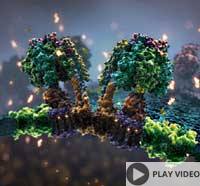 |
Powering the Cell: Mitochondria Harvard University's computer generated animation about the microscopic world of mitochondria, the organelle generating the cell's power. |
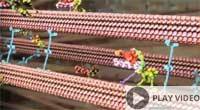 |
Astonishing Molecular Machines |
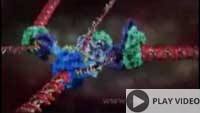 |
DNA Replication (without the error correction mechanisms) see here [2] for an outline of the process. |
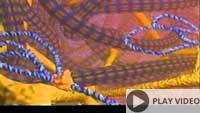 |
Voyage Inside the Cell |
 |
Cell Division and many more short videos |
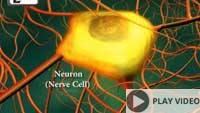 |
Neurons and Nerve Cells see also:the Central Nervous System [3] |
 |
The Immune System (amazing video on microwarfare) see also: T-Cells | Immune Response |
 |
The Water Bear (amazing video on the micro-animal) |
>> Next: Nature's Game
Footnotes